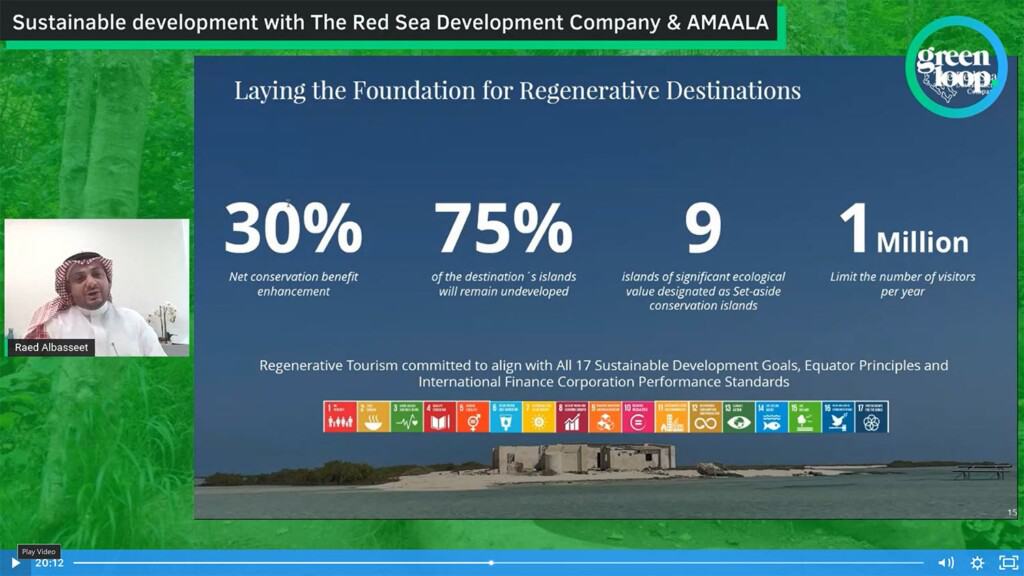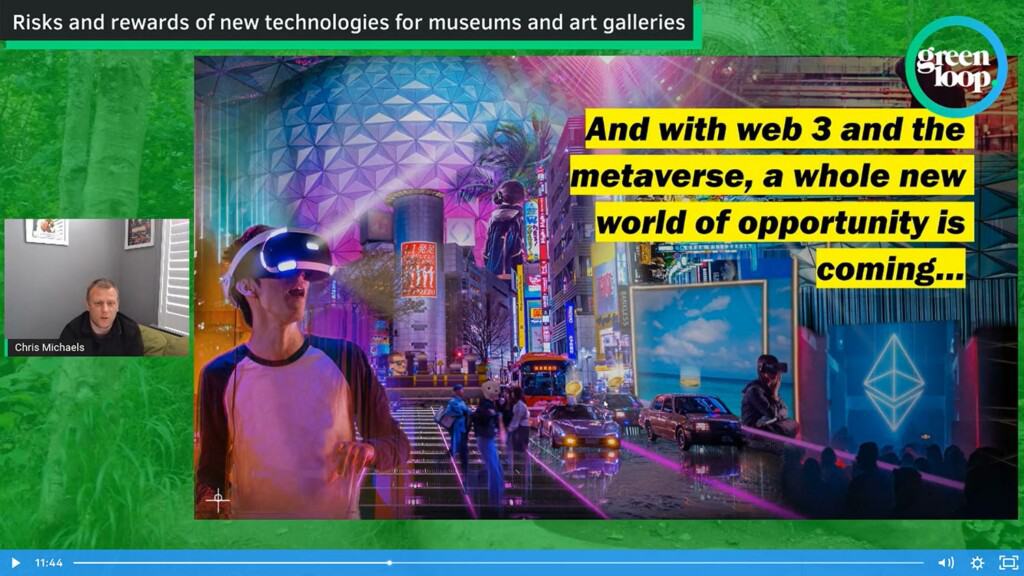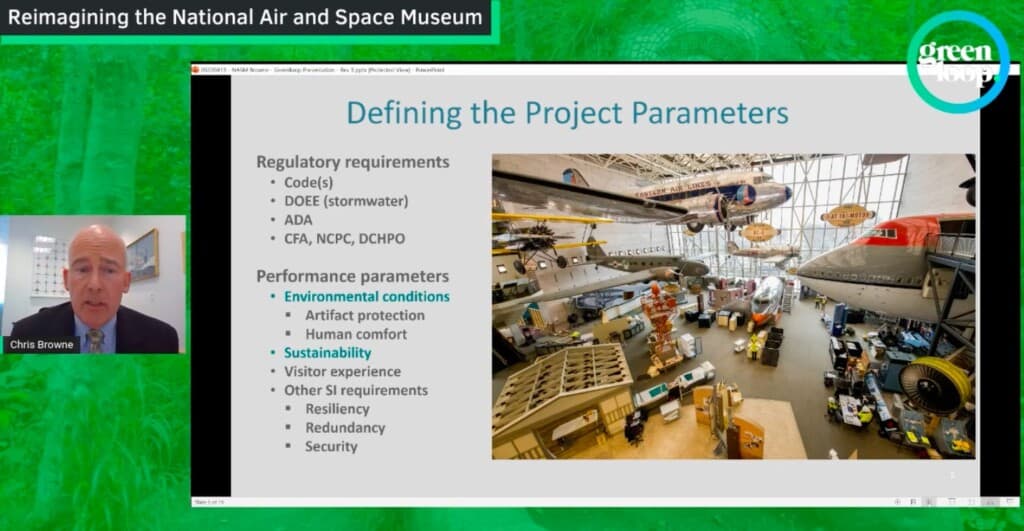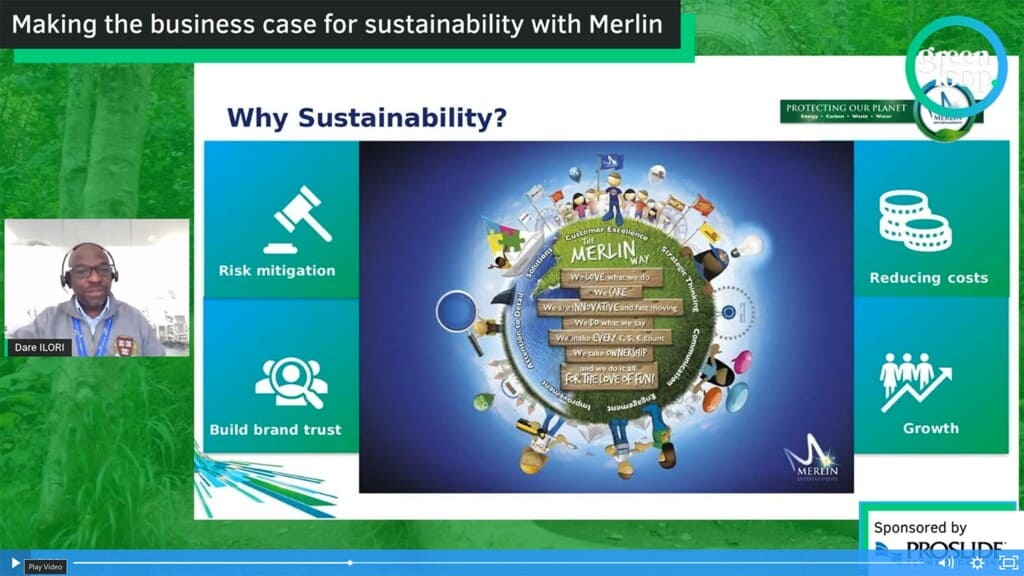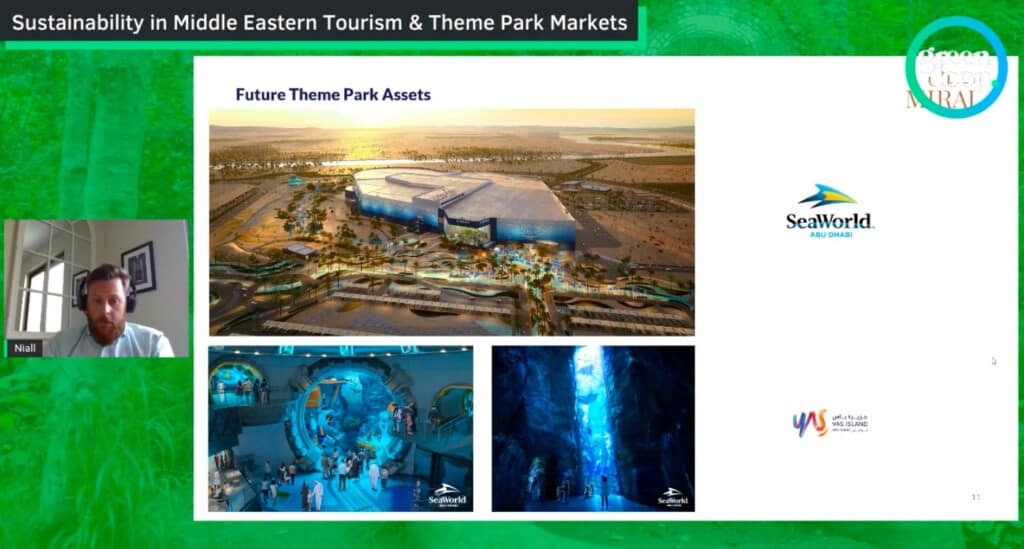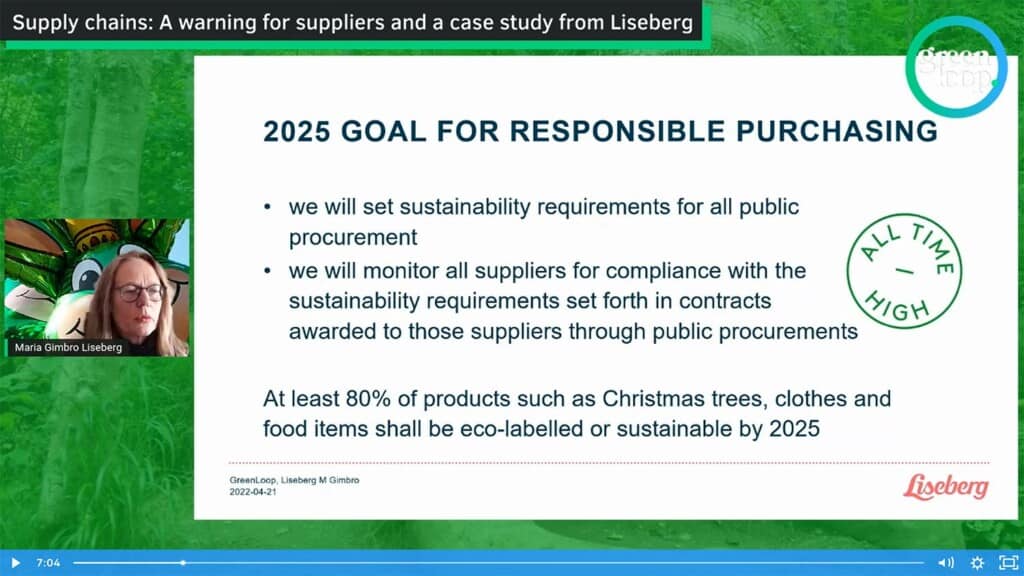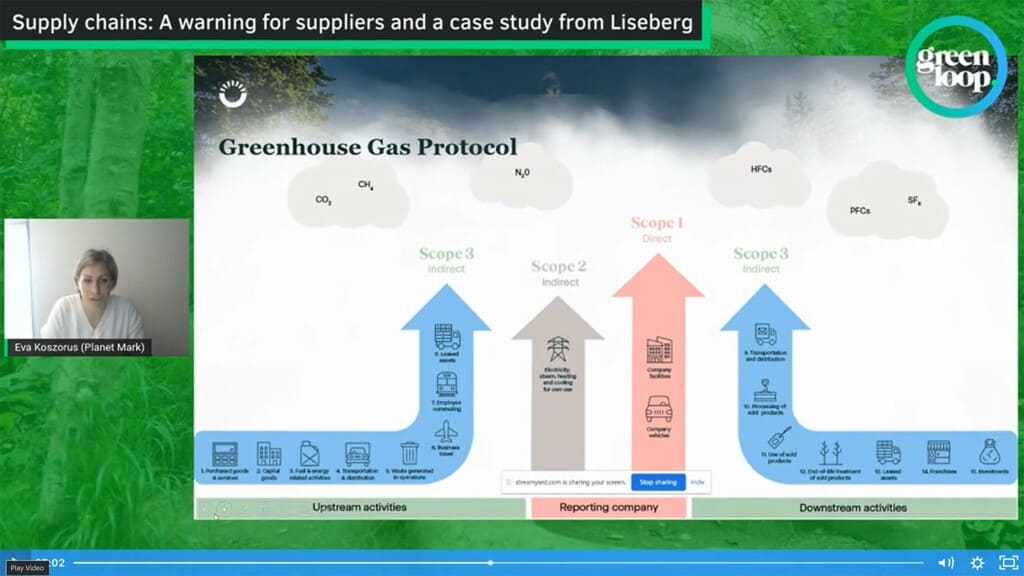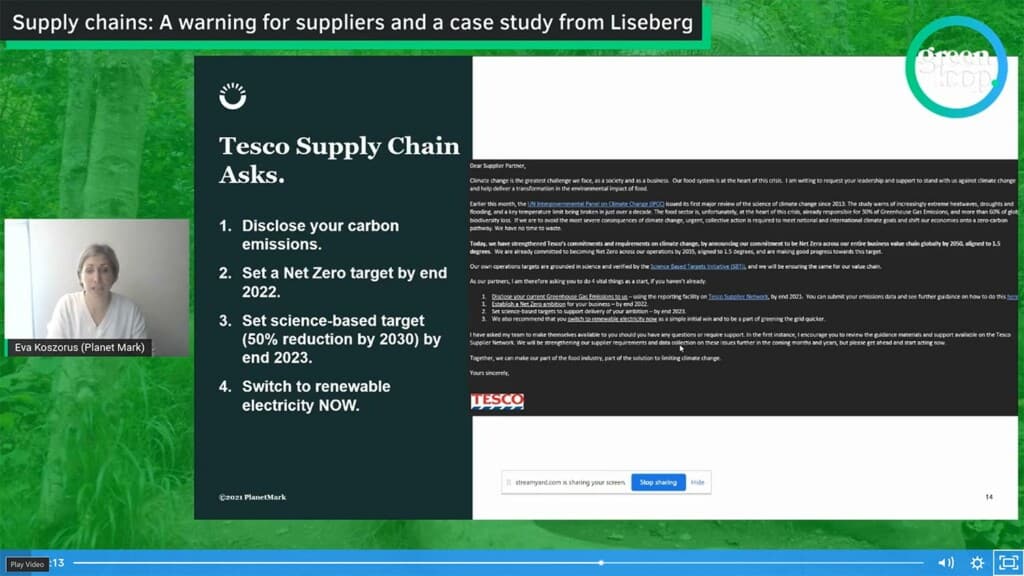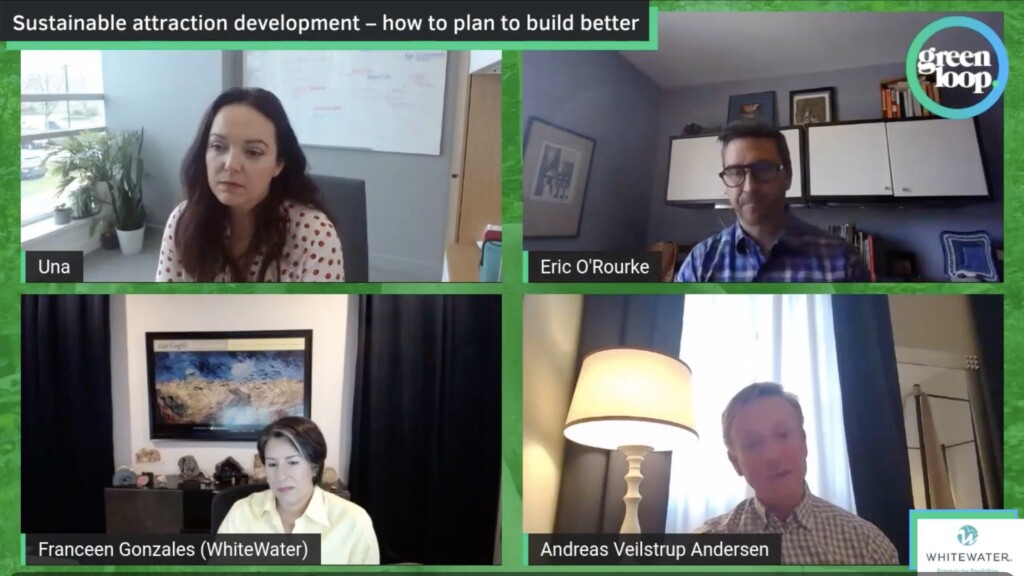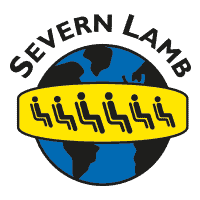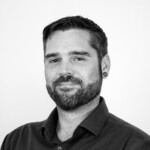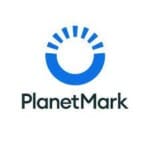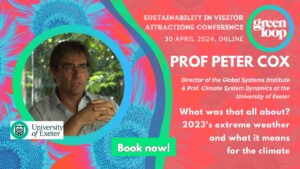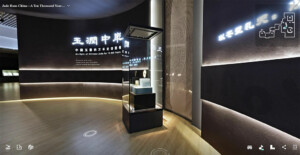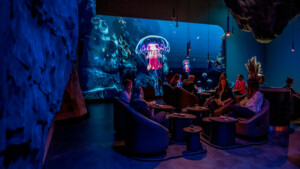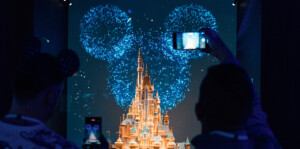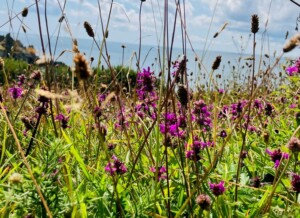greenloop 22, blooloop’s sustainability in visitor attractions conference was held 19-20 April online. Now in its second year, the conference attracted attendees from all over the world and across sectors to learn about the climate action being taken by the operators leading the way.
We are hugely grateful to our amazing speakers, our sponsors and also our 400+ attendees who are always so engaged with the sessions.
The aim underpinning greenloop is to enable attractions and also their suppliers to accelerate the pace of their sustainability initiatives. This is brought about by learning from each other across all sectors, enabled by blooloop’s industry-wide reach.
When it comes to solving really big challenges, like how do we build sustainable theme parks, resorts and cruise ships around the world, it takes all of us and all of these different industries coming together. And that’s what’s great about greenloop … our collaboration is key to really think about how we build sustainable themed entertainment experiences.
Emily Dow, Design Studio Executive with Walt Disney Imagineering at greenloop 2021
Did you miss greenloop 22? You can access the greenloop sessions and materials online until the end of the year for just £24.
(greenloop attendees should have received a coupon code to access for free. Ask Alice at events@blooloop.com if you missed it.)
Thanks to our attendees – we donated £500 to Earth Day’s Canopy Project and £1000 to Project Seagrass from our ticketing revenue.
Key message from greenloop 22 for suppliers – measure!
The clearest message that we got from our speakers at greenloop is that many of them, including Disney, are now starting to look at their Scope 3 emissions and Net Zero targets.
This means that these operators will need suppliers to be able to quantify and report their own carbon footprints. It also means that increasingly, it will be a competitive advantage for suppliers to have a Net Zero plan in place, as carbon cost will be a key factor in procurement decisions.
In addition, operators quantifying their Scope 3 emissions will have to start looking at the impact of their visitors’ journeys.
Beyond Carbon Neutral with Portaventura & Blenheim Palace

Choni Fernandez, Sustainability Director of PortAventura Resort, opened greenloop again this year. PortAventura has led the way in sustainability for theme parks, beginning its ESG journey 25 years ago. In 2020, PortAventura Resort became carbon neutral after reducing its Scope 1 and 2 emissions by 95%, and offset the remaining emissions with a scheme in Guatemala which also includes social as well as environmental goals.
At greenloop 22, Choni provided an update, detailing the next steps.
The graphic (above) shows that climate risk is now considered to be the second highest risk after safety in PortAventura’s materiality matrix.
This year, PortAventura has also committed to Science Based Targets (SBTs). This means that they are looking at all their emissions (including suppliers and visitors), and have pledged to reduce them in line with the 1.5°C required by the Paris Climate Agreement. This challenging target will include working with suppliers to measure and reduce the carbon in purchased goods and services and reviewing visitor travel.
I think that now it’s time to change our mentality as operators … We are going to rank our vendors. We are also going to reward the ones who have this commitment with emissions reduction.
Choni Fernandez
Measuring carbon emissions
Then Dominic Hare, CEO of Blenheim Palace, caught us up with the work that they have done with visitor travel. Blenheim Palace is committed to becoming carbon neutral across scopes 1 to 3 by 2027, and carbon negative by 2050.
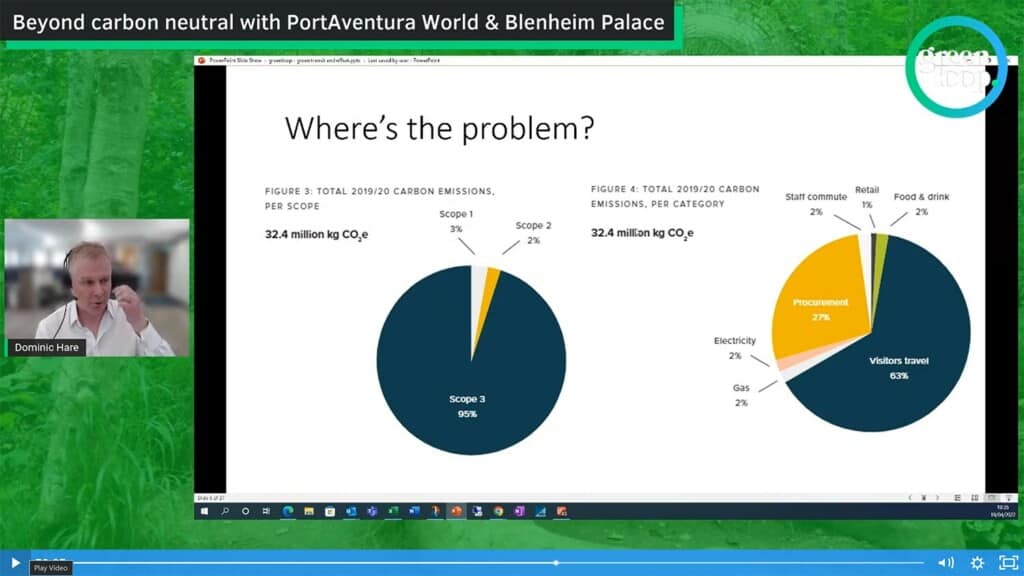
One of the most difficult aspects of this will be to measure and reduce the carbon emissions related to visitors to the historic site. These represent around two-thirds of the estate’s carbon footprint. This is a thorny issue for all visitor attractions. It is especially so for those outside cities or that have a high proportion of overseas visitors. Although difficult, Dominic believes that it is something that visitor attractions have a responsibility to tackle:
We are clearly working very hard to attract people to to emit a lot of carbon to come to us. So we felt from day one we would have to take responsibility for their scope 3 visitor travel if we are to be carbon balanced.
Dominic Hare
Exploring Eden’s radical model for positive change at greenloop 22
The Eden Project is undergoing a period of rapid international expansion. It is developing new sites as its sustainable message becomes more and more relevant.
David Harland, CEO of Eden Project International, joined greenloop 22 to talk about how the New Edens and Wild Sites are a radical model for positive change.
UK locations for new Edens include Dundee, Morecambe, Derry and Dorset. The Eden Project is also heading to the US, China, Australia, New Zealand and Colombia, as well as Costa Rica. The Eden Project in Cornwall also played host to global leaders during the G7 summit last year.
What we really need to see is, is real change from from organisations, individuals and governments. We need them to commit to this journey that we’re on. And I think that’s how we’re going to see change. And I think our role within this is to educate people, to inspire them, to engage them.
David Harland
Sustainable development: The Red Sea Project and AMAALA
The Red Sea Project and AMAALA are Saudi Giga projects with an ambitious green agenda.
We heard from Raed Albasseet, Group Chief Environment and Sustainability Officer at The Red Sea Development Company & Amaala. He talked about how the projects are finding new ways to tackle challenging targets like zero waste, a 30 per cent net biodiversity gain, protection of the coral reefs and more.
Both destinations are going to be free of single use plastics and are going to be carbon neutral. Both projects are also going to be 100% off the grid, 100% powered by renewable energy. There will be zero waste to landfill. We have already started targeting zero waste to landfill by handling all of the domestic waste that is being generated at the moment, but also all of the construction waste that is being generated, and making sure that none of that is reaching any of the landfills.
Raed Albasseet
How to create green NFTs with the Whitworth
Many Museums and Art Galleries have jumped into creating NFTs. With a wealth of artwork to create digital assets it can seem like an easy option to generate revenue. However, many blockchain platforms are horrendous environmentally.
There is an increasing backlash against organisations that use proof-of-work blockchain like Ethereum and Bitcoin. This was illustrated recently with the negative publicity received by the British Museum. The figures are mind-boggling; Ethereum and Bitcoin combined consume more energy per annum than Spain!
Sales of NFTs were in the tens of billions of dollars in 2021. Given the shockingly bad environmental cost, action is needed to curb proof-of-work blockchain (China banned mining in 2021). Museums and art galleries also need to ensure they don’t add to the problem.

Alistair Hudson, Director of the Whitworth and Manchester Art Gallery spoke at greenloop 22 about the Ancient of Days NFT that has been created with the University of Manchester and Vastari Labs. This trailblazing project uses Tezos, an energy-efficient proof-of-stake algorithm blockchain. The experimental “Robin Hood NFT”, the proceeds of which will go to fund community projects, is part of a wider transformation, helping the museum to use art for social change. It is hoped that this will become a blueprint for other galleries also seeking to monetize their collections digitally.
The creation of the “green NFT” is part of a wider research programme with the University of Manchester. This will culminate in an exhibition in 2023, Economics the Blockbuster.
Museums, digital and the climate crisis with The National Gallery
Chris Michaels is Director of Digital, Communications and Technology at the National Gallery in London. He joined greenloop 22 to talk about the relationship between sustainability and technology for museums. In particular, he looked at the opportunities to engage afforded by new digital technologies, and how the related carbon cost creates challenges for museums.
The National Gallery X was set up in 2019 in partnership with Kings College London to explore these questions. Chris explained that this innovation lab is a place to think about what the future looks like for museums in a digitizing world.
It has to be through hopefulness, through optimism and real positive action now that we approach this difficult space that we sit in together … Technology can help us find solutions to the climate crisis; can help us, as museums, find ways to communicate with the world and new ways to solve our own challenges. And I think this is a journey for us all in the years ahead.
Chris Michaels
Making an impact: Bluetech incubators and sustainable palm oil cities
At greenloop 22, we also explored how attractions can extend their influence beyond their footprints. We looked at two innovative and impactful programmes.
Cat Barton is Field Conservation Manager at Chester Zoo. She talked about co-creating the ‘Sustainable Palm Oil Communities’ project, which saw Chester become the world’s first Sustainable Palm City.
Chester Zoo is now working with other communities across the UK and is really keen to expand the programme internationally. To find out how to get involved click here.
What we really wanted to do when we found out about this issue was to encourage a lot more use of sustainable palm oil. We knew that boycotting palm oil wasn’t going to be a solution … So we wanted to increase demand for sustainable palm oil one business at a time. We started with ourselves and then we moved on to others in the community.
Cat Barton
Then, John W. Mandelman, Vice President and Chief Scientist at New England Aquarium, talked about co-founding and partnering the BlueSwell incubator programme.
The $1 million a year programme supports start-up businesses innovating in BlueTech with a grant as well as education, mentoring and networking with local blue economy stakeholder connections.
“An exciting time”
The New England Aquarium has been involved with larger corporations for years as an advisor to promote sustainable ocean development. By helping to nurture new businesses it is hoped that innovation will accelerate, developing not just the blue economy but also creating solutions for a “vibrant and vital ocean”.
I think this is an exciting time for aquariums, for zoos, for other cultural organizations to think about working closely with corporates. We feel like innovation is a major key to the future of sustainability in the ocean and making sure that it stays vital and vibrant. By serving as that conservation voice, that’s the way that we feel we can have the most impact per unit effort in our space.
John W. Mandelman
Applications for Cohort III are now open. You can find out more here.
Creating a staff-led vision at M+, Hong Kong
Penni Hall is Head, Strategic Projects & Governance, and Ria Smith, Manager, Strategic Projects at the recently opened M+ museum in Hong Kong. They spoke about how they have been engaging staff members with the museum’s sustainability journey.
The plan was to embed sustainability in all projects. This was so that all museum-wide activities started to have sustainability not as a separate discussion or activity, but as just something that naturally formed an essential part of the project.
They articulated a Vision Statement. This comprises four workstreams: Collections, Care and Display, Visitor Engagement, Staff Engagement and Travel and Shipping.
The sustainability program has, to date, been a great success.
Since opening, we’ve had some staff changes, yet we’ve actually we’ve retained and enhanced the number of advocates that we have. We’re seeing more senior members of the museum are joining. This gives us a little bit extra sort of leverage, and a cross-departmental view. So it’s a program that is represented by staff at every level. And I think that makes it unique and very intergenerational.
Ria Smith
The circular economy & net-positive development
This greenloop 22 session with Bob Allen, CEO & Chief Storytelling Officer at IDEAS and Bjorgvin Saevarsson, CEO of Yorth Group, focused on the circular economy and creating net-positive development in themed entertainment.
Bob and Bjorgvin emphasised that looking at restorative development, circular economy, and being more sustainable when developing new themed entertainment projects, is where the world is going. And this is not as difficult or expensive as you might think at first.
Bjorgvin then explained that a circular economy is “restorative and regenerative by design. It aims to keep products, components, and materials at their highest utility and value at all times”. Restorative development is “a system-based development approach where environmental, social and economic performances are interconnected and synergistic”.
He emphasised that if you go below net zero into a net negative, whilst you might save money initially, you will be taking that profit from someone else. It won’t be good for the whole, but economies have been built upon short-term financial success. You need to change how you define success and think about the long-term impacts of your project.
Restorative principles include net-zero buildings and blue and green infrastructure, as well as circular material loops and more. Bob then explained that the keys to a net-positive development are to know the market and let the guest drive your project, develop from holistic performance metrics and create a long-term change.
Both Bob and Bjorgvin ended the session by saying that they are seeing more demand for working in this restorative way. Bob explained that “it takes some explaining, particularly when you may be asking for something that is very different to what a supplier is typically used to, [but] …once you walk through it you find people rally to it”.
The National Air and Space Museum
Chris Browne, Acting Director* of the Smithsonian’s National Air and Space Museum, then talked about the exciting $650 Million federally funded expansion and redevelopment of the museum.
It’s a large capital project that will see the entire structure of the museum rebuilt. Chris pointed out that though the exterior will have a similar look and feel, the interior of the museums will be “completely reimagined”.
The museum is huge, taking up three city blocks, and was originally designed to cater for around 2 million visitors a year. Attendance now is around 7-8 million.
Sustainability was a key part of the project. Initiatives included water conservation and stormwater management, improved lighting systems, temperature and humidity control and daylight control. Sustainability has been a guiding factor throughout the project and 85% of the construction material and debris has been recycled.
Chris said that the museum will be able to reduce its energy use intensity by over 47%.
“We’re trying to approach this from start to finish and everything in between, looking for ways that we can truly provide an enhanced visitor experience, in a way that is sustainable and much more efficient than in the past, and importantly, do so in a way that provides added care for our artefacts”.
*Chris became Director of the museum in May ’22.
Serving up sustainability in front-line operations
Lauren Julian, Director of Guest Services at Indianapolis Zoo and Andrea Froehle, VP Marketing & Communications at Event Network explored how to embed sustainability into front-line operations. Lauren explained that “communication is key and you have to have some fun with it”. She gave the example of Artemis, a crow at the zoo who has been trained to recycle cans during bird presentations. This is fun for guests and inspires them to recycle as well.
She also spoke about how the Zoo works with its local community. For example, they have a few days a year in the quiet season where people can come and recycle electrical goods in the zoo car park and get a discount in the Zoo. Finally, Lauren emphasised that it is essential to make sure your staff are on board. They can then explain your strategy to your guests, but they can also suggest improvements based on their day-to-day jobs.
Event Network works with clients like Indianapolis Zoo on all areas of the supply chain to reduce emissions. When you are looking at how to make your shop or food and beverage areas more sustainable, consider downstream and upstream, and conduct an audit of where you are today so you know where you can make changes.
Andrea said that it is important to ask those working on the shop floor, who are unpacking products, where there is waste in that product. You can then go back to your product suppliers and work out how it can be packaged better.
Lauren ended by saying “look around and constantly be questioning, is this where it should go and what can I do next. It’s amazing what small steps continue to make the big impacts.” Andrea agreed, and said that “no step is too small”.
Carbon neutral zoos at greenloop 22
Kiam Yoong, Senior Manager of Environmental Sustainability, joined greenloop 22 from Zoos Victoria. He talked about how Zoos Victoria was the first zoo group in the world to become carbon neutral back in 2013. Kiam also shared progress on key projects. For instance, green power, water recycling, zero waste to landfill, offsetting and ESG procurement scorecards.
He noted that one of the most important sustainability projects is around staff education. Zoos Victoria has implemented an online internal qualification for staff for competency and awareness – the Online Wisdom & Learning System or OWLS.
EMS part is about everybody’s responsibility, right? So it’s about bringing staff as well to that journey. And I think this is really important because in all organizations, it’s not just the sustainability managers or whatever doing the job. It’s about everybody being skilled up to understand what their role is and understand what the impacts are right when they’re doing their work in terms of impacts on the environment, how they can actually manage their work more sustainably.
Kiam Yoong
Duncan East is Head of Sustainability at Marwell Wildlife. He talked about the Zoo’s journey to carbon neutral and beyond, including their headline-grabbing “zoo poo” renewable energy initiative.
Duncan explained how Marwell has reduced its carbon footprint by focusing on energy consumption and renewables. Marwell has reduced its carbon footprint from around 1700 tonnes in 2008 to just over 200 tonnes. This is through projects including lighting and solar panels as well as creating a circular economy gift shop. He noted that carbon marks on products are becoming more and more common.
As a starting point, Duncan recommends measurement using an environmental management standard:
We’ve both done the ISO 14,000 route, and that’s a very good way to start some form of environmental management system that helps you to just identify what all your AMBER impacts are and gives you an idea of ranking them so you know what your biggest impact is.
Duncan East
Getting the board on board at Merlin
Often, the most challenging aspect to starting a sustainability programme or getting funding for green projects is getting the buy-in from your organisation’s leadership.
Dare Ilori, Sustainability Director for Merlin Entertainments, gave us some top tips on how to make your case. This includes getting key board members on side before meetings and showing the value to the business of your proposals.
There are four tools that you can use to explain why sustainability is important to anybody, anywhere in the world. We need sustainability because it helps us. It helps to mitigate against risk and to build brand trust. It also helps to reduce costs and it helps with the business growth.
Dare Ilori
Miral: leading the way in the Middle East
Niall Murphy is Senior Manager MEP at Miral, the leading investment company responsible for the development and management of Yas Island in Abu Dhabi. He talked to greenloop 22 attendees about Miral’s sustainability journey and sustainability in the Middle Eastern tourism and theme park markets in general.
In explaining Miral’s role in the region, Niall stressed it was not, “a developer that builds something to increase the tourism industry within Abu Dhabi, then hands the asset over to someone else. We’re there right from, the seed of an idea all the way through to operating the asset for the next 30 to 50 years”. At Miral, they develop, build and operate, they are full-cycle.
This allows them to “really look at and interrogate our design at the early stages to ensure that we are developing something which is sustainable and that reduces our operational costs”.
Niall talked about the particular challenges involved with operating attractions in the heart of the UAE. He also highlighted Miral’s Yas Bay project. This is the first multi-purpose hall in Abu Dhabi. It was awarded the “Sustainable Design of the Year” award in 2018.
The distinctive design of Yas Bay combines both sustainable and cultural features. Sustainability was integral to the design. The materials provide adequate levels of sunlight and thermal insulation helps to reduce energy consumption. Systems in the building reduce energy and water consumption and provide 22.4% of the energy and 28% of the water.
More recently Miral has created Abu Dhabi’s largest rooftop solar photovoltaic project at Warner Bros World Abu Dhabi on Yas Island. “Once completed,” Niall said, “it will supply 40% of the Warner Brothers world energy usage just from the PV array on the roof”.
Niall also touched on SeaWorld Abu Dhabi, one of the world’s most hotly anticipated theme park projects.
Sustainability isn’t just about energy usage. It isn’t just about reducing our carbon footprint. It’s also about education. And Miral’s partnership with SeaWorld as an IP holder is really one of those instances where education runs throughout the whole story of a theme park.
Niall Murphy
Supply chains: A warning for suppliers at greenloop 22
Maria Gimbro is Purchasing/Procurement Specialist at Liseberg. She set out how the theme park is addressing the carbon cost of its supply chain.
In a survey in 2020, 92% of Liseberg’s guests said that they thought it is important or very important for the theme park to work towards sustainable development.
Sustainability is not only about the survival of the planet. I believe that it’s also about the survival of our business.
Maria Gimbro
So Liseberg is taking action and has a goal to be a world leader in sustainable park operations by 2025. Responsible purchasing is one of the five key elements of Liseberg’s sustainability strategy.
It’s not something that can be handled solely by a separate department. It’s more about putting on a different hat, looking at things differently and asking different questions; a way of thinking, breathing, acting. It should permeate everything we do, including challenging our own behaviour, the way we think, what we purchase and how we do it.
Maria Gimbro
Eva Koszorus, Business Development Manager at Planet Mark talked about why suppliers need to know what their carbon footprints are ASAP.
Carbon jargon
She started by giving some useful definitions of “carbon jargon”, explaining that an attraction operator’s Scope 3 emissions include their supplier’s Scope 1 and 2 emissions. When operators what to measure their carbon footprints to work towards net zero, they will need their suppliers to provide this data. In addition, when operators are looking for ways to reduce their carbon footprint they are likely to choose suppliers who can quantify their own emissions and have a strategy in place to minimise them.
Aside from the moral duty to take climate action for the planet and future generations, there are regulations in force, and more coming, which require companies to act. In the UK alone, all companies are required to reach Net Zero by 2050. Government procurement rules for all projects over £5 million require applicants to have a plan to do so now. This means that companies need to know their current carbon footprint to be able to bid.
Having a credible net zero strategy will be the cost of doing business in the future and large organisations are building net zero actions into their tenders and the supply chain having to set net zero targets. So there’s a real competitive advantage for companies who are treating this as an opportunity to differentiate themselves from the competitors.
Eva Koszorus
And this could filter down the supply chain very quickly. Eva showed us an email from Tesco to all their suppliers in the last quarter of 2021 requesting carbon data by the end of the year!
Planet Mark has offered a discount to greenloop attendees and blooloop clients wanting to join them. Please contact Jonathan (jonathan.withey@planetmark.com) to find out more.
Museums at greenloop 22: Carbon literacy toolkit & Carbon neutral touring exhibitions
Alison Criddle is Museum Carbon Literacy Officer at Museum Development North West. She spoke at greenloop 22 about the Carbon Literacy Toolkit and how museums can use it. The Carbon Literacy Project gives an awareness of the carbon cost of everyday activities. It gives organisations and individuals the motivation and ability to reduce emissions.
Alison emphasised that museums can reduce their own carbon footprint, through their exhibitions, buildings etc. Plus they can also empower their communities and create spaces for action. They can tell stories of climate change and influence, advocate and be role models. The Toolkit itself has a trainer manual, activity packs, resource lists, streaming links and more to help organisations.
Tim Pethick, CEO and Founder of Nomad Exhibitions explored how to create a carbon-neutral touring exhibition. He emphasised that when you are looking at becoming carbon neutral and measuring your carbon footprint, you should always start with reducing, measuring, designing and engineering considerately, reusing and then finish with offsetting.
Carbon offsetting
Carbon offsetting is not a reliable means to reduce carbon tonne for tonne. Instead, it should be used as a last resort in your carbon strategy. He also said that it’s a great idea to put the carbon footprint of an exhibition on display. This means visitors can understand what you’re doing to reduce emissions.
Tim believes that operators should be more demanding of their suppliers, and put sustainability into briefs and tenders. However, consultants should also be self-driven and people should take the initiative.
“This is where everything is moving. Everything is going to become more sustainable. Everyone is going to want to know what the carbon footprint of your work is, so the sooner you start to embrace that and get on that escalator of sustainable knowledge, the better. It takes a long time…so you just have to get on and do it. Importantly, you have to understand that it’s not all going to be easy and there will be mistakes and missteps along the way. But doing something is better than doing nothing at all”.
Tim Pethick
Tim is also a gold level member of the UN’s Climate Neutral Now programme – see below.
Floriade presents greener cities at greenloop 22
greenloop 22 attendees then heard from Frank Cornelissen, the Chief Commercial Officer at the Floriade Expo 2022. Floriade is an International Horticultural Exhibition taking place in Almere, the Netherlands, from April to October 2022.
The main theme of the Expo is “Growing Green Cities”: how we can make our cities green, better, healthier and future-proof. It is, also, all about sustainability. The team expect up to 2 million visitors over the course of the 6 months.
Frank made the point that one thing you won’t see at Floriade is avocado on toast. This is because they are not grown locally. There is a restaurant on-site, part of the Food Forum, the pavilion for the province of Flevoland. The chef cooks using only plant-based, with all ingredients coming from a maximum of roughly half a mile away. For all partners who sell food on-site, 80% of the ingredients must come from within 500 kilometres of the expo.
“This also means that we’re working with predominantly plant-based meals, vegetarian and vegan meals. We’re only doing seasonal because anything out of season has a bigger environmental impact.”
We’re hopeful that we can show our visitors that local food doesn’t mean it’s not as good. If you want chips, you can get chips. But they’re going to be from local Flevoland potatoes and sustainable vegetable oil. We’re going to give you what you want because it’s a day out and it should be fun, but it’s also going to be sustainable and on message. Ultimately, we don’t just want to tell them our message, we want them to experience it.
Frank Cornelissen
Good journeys at greenloop 22
Nat Taplin is the founder\director of Good Journey. This is a company that encourages visitors to attractions and leisure experiences across the UK to take car-free journeys.
One in four UK households doesn’t have a car. Of those that do, around 40% of their travel is for leisure. A significant portion, over 60%, of an attraction’s carbon emission comes not from the attraction itself but from the travel their visitors take to get to them.
Nat gave Blenheim Palace as an example.
It offers a generous discount 30% off admission which represents about £10 off for an adult ticket. It links to their Good Journey page and that page gets about 500 views a week: it’s the most clicked external link on the Blenheim Palace website. Blenheim has really prominent messaging about green travel on its website and on their visitor leaflet. Just those simple steps have resulted in a 500% upturn in car-free visitors over two years from 5,000 to over 30,000.
Nat Taplin
Climate Neutral Now: Support from the UN for businesses
Miguel Naranjo is Programme Officer for Global Climate Action at the United Nations Framework Convention on Climate Change Secretariat. He talked to greenloop 22 attendees about the UN’s Climate Neutral Now Programme. The Programme offers free support for businesses who want to start to measure their carbon footprint.
The full presentation is available below:
Climate change is threatening the very foundations of our society. We are coming dangerously close to a point where our society, as we know it, will no longer be able to function. The only way we are going to avoid reaching that that point is working together.
Miguel Naranjo
Any suppliers that have an interest in starting to measure their carbon footprints, please get in touch with us here. Blooloop is setting up an informal working group, and we would love to hear from you.
Buro Happold: The Theatre Green Book
Andrew Wylie, Partner at Buro Happold spoke about the Theatre Green Book that Buro Happold produced in conjunction with theatres. This help book gives practical advice for theatres to become more sustainable. It focuses primarily on scope 1 and 2 emissions. However, there is also some content on scope 3 emissions to help attractions at every stage of their sustainable journey.
Buro Happold is currently working on a Museum Green Book. Andrew urged any other sectors within the industry that have an interest in working on a Green Book to get in touch. In response to a question, Andrew said that the greatest sustainable success will happen when responsibility is shared by everyone within an organisation.
But there is a need to coordinate and hold people to account for projects and plans. It can therefore be helpful to have a Board member who has ultimate responsibility for these sustainable initiatives.
Sustainable attraction development with Whitewater at greenloop 22
Andreas Anderson, CEO of Liseberg, Eric J O’Rourke, Senior Director of Theme Parks at Forrec and Franceen Gonzales, Chief Experience Officer at WhiteWater spoke in a panel session moderated by Una de Boer, Chief Marketing Officer at WhiteWater.
They discussed how to build more sustainably and how attractions and suppliers can work together to do this. One of the key messages was that suppliers and operators should incorporate sustainability into everything they do. It should be part of their ethos. Guests vote with their wallets and will start choosing sustainable companies.
Eric also emphasised that you should think about sustainability from the beginning. It should be in the feasibility studies, the designs, ride package selection, all the way into the RFPs. Make sure it’s one team, not separate teams when working on this. Also, be flexible to add new technology when working on a new project when it appears. You can even change any projects you’re working on now.
Andreas and Eric said that you should quantify your emissions so you can have a target and measure yourself against your aspirations. Eric explained that: “it’s important to quantify…it’s ok if you fall short but you have to have a target and strive to hit a number and reduce your carbon.”
Without a target, you won’t know if you are achieving your aims. Andreas also highlighted that a key thing for operators is to engage their staff and break down a project. Start with one issue and then keep going from there. Franceen highlighted that you don’t have to do everything at once. You should start with an aspiration, and do one thing at a time.
Disney: putting environmental goals into action
Emily Dow is the Design Studio executive for Walt Disney Imagineering. She is also the co-leader of the global Design & Delivery Studio, where she leads the interdisciplinary design team who creates the built worlds of Disney’s theme parks, resorts, and cruise ships.
She was joined at greenloop 22 by Caitlin Krasovic, a Senior Architect at Walt Disney Imagineering. Caitlin is currently focusing on Sustainable Design and integrating The Walt Disney Company’s 2030 Environmental Goals into Imagineering’s global portfolio of projects. Emily and Caitlin both spoke at greenloop, updating us on WDI’s progress since last year.
Disney has recently launched a dedicated ESG impact website and further defined its environmental goals:
We are committed to reducing our greenhouse gas emissions beyond our direct operations to include the production and delivery of our products and services, commonly referred to as Scope 3 emissions. Our intention is to define a science-based reduction goal for The Walt Disney Company’s Scope 3 emissions footprint by the end of 2022.
https://impact.disney.com/environment/environmental-sustainability/
Scope 1, 2 and 3 at Disney
Emily and Caitlin explained to greenloop 22 attendees how WDI has created global sustainable design standards and processes. These currently cover Scope 1 and 2, which underpin all their work. Sustainability is part of the project process. In addition, there is an R&D function to tackle difficult problems that can’t be addressed within a project.
We’ve been crafting a robust set of global sustainable design standards.We’ve aligned these with the categories of the 2030 environmental goals to include detailed descriptions of the minimum requirements and lessons learned and best practices that our project teams around the world can implement … we are kicking off every single new project with an overview of the company’s commitments, highlighting these standards and starting to brainstorm early in that blue sky process. The various ways that they can integrate sustainable design to their story and to their scope. So to partner with the standards, we also have a checklist tool that helps support project teams. As their designs are taking shape. It’s a system that they can utilize to really track how their specific scope is progressing towards achieving the environmental goals. It is also a way to capture the sustainable stories that have inherently been woven into their designs.
Caitlin Krasovic
These will then be extended to encompass Scope 3. Emily emphasized how important it will be for the whole industry to work together:
And what I really hope is at this conference, after this conference, through follow up calls we work together to push the industry to really look at Scope 3 emissions. I hope we can encourage the manufacturers and suppliers to provide greener alternatives and also our government partners and our regional agencies to invest in sustainable infrastructure projects. If we pull together as an industry and we all have this laser focus on on solving and putting action towards Scope 3 emissions, I think we can make some real change.
Emily Dow
Save the date: greenloop 23
It’s a long way off but put it in your diaries now!
Next year, greenloop will take place online on 25 & 26 April 2023. We’re always looking for interesting topics and sponsors. So, please do get in touch with Alice at events@blooloop.com if you would like to be involved.
Thanks to our greenloop 22 sponsors
And finally, a huge thanks to our sponsors, without whom we could not put on our events.


